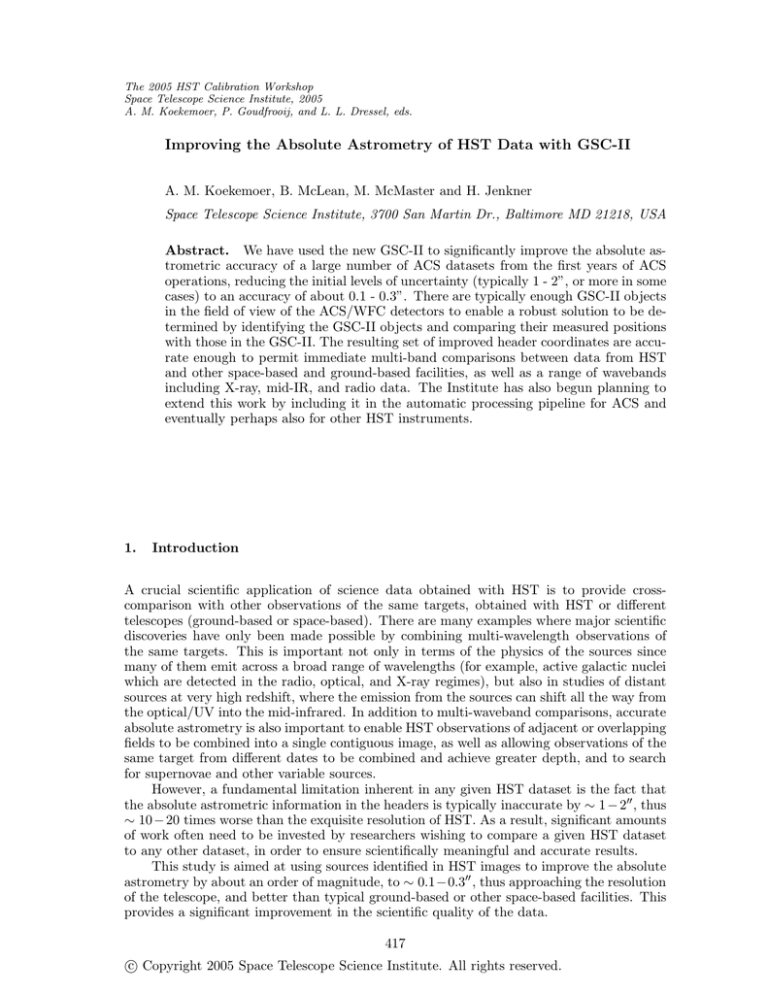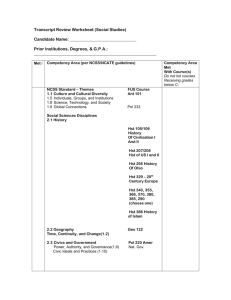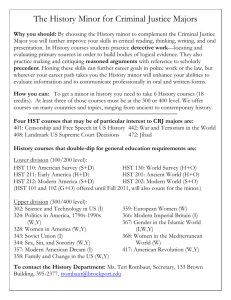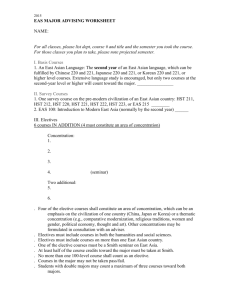
The 2005 HST Calibration Workshop
Space Telescope Science Institute, 2005
A. M. Koekemoer, P. Goudfrooij, and L. L. Dressel, eds.
Improving the Absolute Astrometry of HST Data with GSC-II
A. M. Koekemoer, B. McLean, M. McMaster and H. Jenkner
Space Telescope Science Institute, 3700 San Martin Dr., Baltimore MD 21218, USA
Abstract. We have used the new GSC-II to significantly improve the absolute astrometric accuracy of a large number of ACS datasets from the first years of ACS
operations, reducing the initial levels of uncertainty (typically 1 - 2”, or more in some
cases) to an accuracy of about 0.1 - 0.3”. There are typically enough GSC-II objects
in the field of view of the ACS/WFC detectors to enable a robust solution to be determined by identifying the GSC-II objects and comparing their measured positions
with those in the GSC-II. The resulting set of improved header coordinates are accurate enough to permit immediate multi-band comparisons between data from HST
and other space-based and ground-based facilities, as well as a range of wavebands
including X-ray, mid-IR, and radio data. The Institute has also begun planning to
extend this work by including it in the automatic processing pipeline for ACS and
eventually perhaps also for other HST instruments.
1.
Introduction
A crucial scientific application of science data obtained with HST is to provide crosscomparison with other observations of the same targets, obtained with HST or different
telescopes (ground-based or space-based). There are many examples where major scientific
discoveries have only been made possible by combining multi-wavelength observations of
the same targets. This is important not only in terms of the physics of the sources since
many of them emit across a broad range of wavelengths (for example, active galactic nuclei
which are detected in the radio, optical, and X-ray regimes), but also in studies of distant
sources at very high redshift, where the emission from the sources can shift all the way from
the optical/UV into the mid-infrared. In addition to multi-waveband comparisons, accurate
absolute astrometry is also important to enable HST observations of adjacent or overlapping
fields to be combined into a single contiguous image, as well as allowing observations of the
same target from different dates to be combined and achieve greater depth, and to search
for supernovae and other variable sources.
However, a fundamental limitation inherent in any given HST dataset is the fact that
the absolute astrometric information in the headers is typically inaccurate by ∼ 1 − 200 , thus
∼ 10 − 20 times worse than the exquisite resolution of HST. As a result, significant amounts
of work often need to be invested by researchers wishing to compare a given HST dataset
to any other dataset, in order to ensure scientifically meaningful and accurate results.
This study is aimed at using sources identified in HST images to improve the absolute
astrometry by about an order of magnitude, to ∼ 0.1−0.300 , thus approaching the resolution
of the telescope, and better than typical ground-based or other space-based facilities. This
provides a significant improvement in the scientific quality of the data.
417
c Copyright 2005 Space Telescope Science Institute. All rights reserved.
418
2.
Koekemoer et al.
Sources of Astrometric Inaccuracies in HST Data
A major source of uncertainty in the absolute astrometry of HST data arises from the Guide
Star Catalog I (GSC-I; Lasker et al. 1990; Russel et al. 1990; Jenkner et al. 1990) which has
been used in the HST operational system for all cycles up to Cycle 14. The astrometry for
any given observation is derived by assuming the location of the guide star to be accurately
represented by its coordinates in the GSC-I. Subsequently, the telescope calculates an offset
between the coordinates of the guide star and the target, and performs a slew that would
place the target exactly at the correct location on the instrument aperture if the guide star
position is accurate; the astrometry of the image is subsequently calculated on this basis.
If the guide star is at a slightly different location on the sky, the astrometric header for
the image remains unchanged, but the target is not placed at the correct position on the
detector and the resulting astrometry for the entire image is incorrect.
The typical level of uncertainty of guide star positions in GSC-I is ∼ 100 although some
objects can deviate by up to ∼ 2−300 (or more). These uncertainties arise from a combination
of factors, including uncertainties in the plate solutions describing the distortion of the
photographic plates, nearby stars, plate artifacts or other confusing sources that can affect
the measured position, as well as the lack of proper motion information for guide stars in
GSC-I, which can place them at a different position than expected.
An additional source of uncertainty arises from the location of the instrument apertures
and the Fine Guidance Sensors (FGS) relative to one another in the HST focal plane. It
has been demonstrated that over long periods of time, the instrument and FGS apertures
can drift as a result of long-term changes in the structure of the telescope. These shifts
can be comparable to the arcsecond-level uncertainties in the GSC-I; although they can be
corrected on a routine basis with aperture updates, they nevertheless represent a significant
additional source of uncertainty in determining the absolute astrometry of an image, even
if the guide star position is known with complete accuracy.
3.
General Methodology to Improve Absolute Astrometric Accuracy
The first step toward improving the astrometric accuracy begins with using the revised
version of the Guide Star Catalog II (GSC-II; McLean et al. 2004; McLean 2006), which
has greatly improved astrometry (∼ 0.2500 r.m.s.) and also contains far more objects, at
least ∼ 5 × 108 . In addition, GSC-II contains well-measured proper motions for all stars
for which this is an important effect. Thus, the absolute astrometry of any given image
can be immediately improved to some extent by examining the change in coordinates of
its primary guide star from GSC-I to GSC-II. Starting in Cycle 15, GSC-II will be used
in HST operations and will thus automatically produce more accurate astrometry for new
data, but for older data this change needs to be applied retro-actively.
However, updating the guide star positions does not address any potential uncertainty
in the instrument aperture locations, and in addition the final astrometry in the image
would still be dependent upon the position of a single guide star. Although the r.m.s.
positional accuracy of GSC-II is better than GSC-I, individual stars can still deviate by
several times the r.m.s, thus up to 100 or more.
Therefore, a more direct means of improving the absolute astrometry of an image is to
identify all the GSC-II sources that are on the image, and use their collective positions to
reduce the contribution of errors from any single source to the overall astrometric correction.
Not only does this provide a more accurate position if all the objects are well-behaved, but
it provides additional protection against being adversely affected by a single bad object,
since such objects can be rejected iteratively.
A crucial consideration in identifying GSC-II objects on the images is that the image
should cover a sufficient area of sky to ensure the presence of a sufficient number of such
Improving the Absolute Astrometry of HST Data with GSC-II
419
sources. If an exposure is too shallow or if the field of view is too small to contain any such
objects, then the only available options are to update the astrometry based on the improved
guide star position, along with the best knowledge of the location of the instrument in the
telescope focal plane. This can be tracked with time and is the subject of another study.
4.
The Present Study
In this study we consider primarily the technique of using GSC-II objects identified on the
images themselves to improve the astrometry. Given the space density of GSC-II objects
across the sky (∼ 12, 000 per square degree, on average, to the sensitivity limits of the
plates), the best instrument on HST to provide a demonstration of this technique is the
Advanced Camera for Surveys / Wide Field Channel (ACS/WFC), which covers ∼ 30 on a
side and therefore will contain ∼ 30 GSC-II sources on average. In practice, fields at high
galactic latitudes generally contain ∼ 5 − 10 sources on a given ACS/WFC image, while
fields near the galactic plane may contain up to 100 or more sources in extreme cases.
After demonstrating this technique for ACS/WFC, it can then be applied to data from
any of the other instruments that have a sufficient number of GSC-II sources in the field
(i.e., STIS, WFPC2 and NICMOS, as well as ACS/HRC and ACS/SBC), although such
datasets will likely only be a fraction of the full range of datasets for these instruments since
they have much smaller fields of view than ACS/WFC.
In order to provide a good demonstration of the general applicability of this technique,
it needs to be shown to work for a wide range of different types of targets, through different filters, and using different observing strategies. We chose to examine the first year of
ACS/WFC data (all of which are now public), in all the broad-band and medium-band filters, for all exposure times and observation strategies. The initial search for all ACS/WFC
datasets in the HST archive yielded a total of 20,010 datasets (with an average of 3 exposures in each dataset). For the present study we excluded data from SM3B, calibration,
engineering and parallel exposures (although the latter may be included in a future study),
and also excluded several large programs (including GOODS, UDF, and COSMOS), for
which the science teams themselves have already produced improved absolute astrometry
based on extensive ground-based imaging. The resulting sample of all broad-band and
medium-band prime ACS/WFC external science exposures yielded a total of 2,492 datasets
obtained during the first year of ACS operations.
5.
Technique Used to Improve Absolute Astrometry
There are fundamentally two different types of exposures in our final dataset:
1. A single exposure of a given field
2. Exposures that form part of a multi-exposure dataset
As a first step, we chose to concentrate on the second category of datasets, namely those
with more than one exposure on a given field. The fundamental reason for this is that
cosmic rays play a significant role in producing spurious source detections on an image,
since several thousand of them are typically present on any exposure longer than a few
minutes. Therefore, we found that astrometric registration of single-exposure images, while
also possible in principle, required significantly more fine-tuning than in the case of multiexposure datasets where the exposures could be combined to reject cosmic rays and produce
a clean catalog. Single-exposure datasets will be discussed in a future study, while for
the present demonstration we discuss astrometric improvements made to multi-exposure
datasets.
420
Koekemoer et al.
Multi-exposure datasets were defined as those satisfying the following criteria, in order
to allow satisfactory combination:
1. executed within the same visit, on the same target
2. using the same camera (ACS/WFC)
3. using the same filter
This definition allowed exposures to be grouped together if they were part of a prespecified dither pattern (i.e., reproducing the current rules for creating associations from
dither patterns), but in addition allowed exposures to be grouped together if they had been
specified using POS TARGs or no dithering at all, yet satisfied the given criteria.
Each multi-exposure dataset was then run through MultiDrizzle (Koekemoer et al.
2002), which automatically aligned the individual exposures, made a clean “median” image,
and then used the clean image to perform cosmic ray rejection before using Drizzle (Fruchter
& Hook 2002) to combine all the input images onto a single, clean output image.
A catalog was then created from the clean output image. We investigated both SExtractor (Bertin & Arnouts 1996) as well as the IRAF DAOFIND software (Stetson 1987), and
chose the latter since we were primarily interested in detecting stars, for which DAOFIND
is able to provide more accurate centroiding. The DAOFIND parameters were then set to
produce a catalog of stars on each drizzled, combined image, yielding their R.A. and Dec.
positions as computed from the image header astrometry keywords. This catalog was then
cross-correlated with the relevant section of the GSC-II, allowing an initial tolerance of 500
and refining the positional offset iteratively until the shifts converged. In each case, the
free parameters solved for included shifts in R.A. and Dec. We also initially considered
solving for the small rotational offsets that can be introduced as a result of the guide star
uncertainties. However, there are typically not enough GSC-II sources on a given image
to allow rotations to be reliably determined, therefore we focus on solving for the shifts in
R.A. and Dec., which represent the dominant uncertainty in the absolute astrometry.
Figure 1: (Left) Example of the typical degree of scatter (in arcsec) in the comparison of
measured vs. catalog positions for GSC-II objects on a representative drizzled image, after
having removed the net offset in R.A. and Dec. originally present in the header astrometry,
which for this image was ∼ 1.700 . (Right) A 6000 -wide portion of the same image, showing
the identified GSC-II objects after the net shift in R.A. and Dec. had been removed. Circles
mark the positions of sources in the catalog compared with their measured locations on the
image.
Improving the Absolute Astrometry of HST Data with GSC-II
421
Once the shift had been solved for the drizzled image, the values were then propagated
back to the distorted frame of each input exposure (the “FLT” file), since ultimately the
goal of this project is to improve the absolute astrometry of each exposure. However, for
the purposes of this study, we present the offsets in R.A., Dec. for each drizzled image,
since this is most directly relevant to the purpose of this study.
6.
Results
800
600
400
200
0
0
1
2
3
4
Original astrometric error ∆r (arcseconds)
5
Percentage of sources with offset > ∆r
Number of exposures with error < ∆r
After running DAOfind and automatically updating the drizzled image header coordinates
with the resulting shift in R.A. and Dec., the new measured coordinates for all GSC-II
objects on the image were computed and compared with their coordinates in the GSC-II
catalog. In Figure 1 we show a typical plot, for an image that contained 86 matched sources
from the GSC-II. This shows the typical spread in the locations of a given source, as well as
the fact that some significant outliers generally exist even for GSC-II, although the peak of
the distribution is very well behaved, with a 1-σ scatter of only ∼ 0.2 − 0.300 . The outliers
are often fainter objects near the plate limit, since we are using the full GSC-II catalog
in carrying out these comparisons. However, it is encouraging to note that many of the
non-stellar GSC-II sources are also very well behaved, even though they are often ∼ 2 − 3
magnitudes fainter than the typical guide star magnitudes. All the drizzled images and
plots were visually inspected to ensure that the algorithm had computed the correct shifts
in all cases, and that image artifacts and other problems were not causing mis-registrations.
In Figure 2 we present the measured shifts for the full set of 152 combined, drizzled
broad-band images in our sample, which altogether contain a total of 834 exposures. Each
combined dataset represents an association (either resulting from a dither pattern or a set
of POS TARG exposures with common filters), and contains exposures from the same visit,
hence with the same guide stars. Therefore, the R.A. and Dec. shifts obtained from the
drizzled image can be applied to all the input exposures comprising that image, since the
same guide star was used on all the exposures with at most a re-acquisition (e.g., exposures
obtained during different orbits of the same visit). It can be seen that less than 35% of
the exposures had an original astrometric error less than 0.500 , while more than about half
of the exposures had an original astrometric error > 100 , and ∼ 25% had an error > 200 .
After applying the astrometric corrections, we re-measured the locations of all sources in
the images compared with their GSC-II coordinates. This showed that the majority of the
images have have an astrometric error < 0.25 − 0.500 , and only 10% have an error > 0.7500 .
Hence, these corrected images approach the intrinsic positional accuracy of GSC-II.
100
80
60
40
20
0
0
1
2
3
4
Residual astrometric offset ∆r (arcseconds)
5
Figure 2: (Left) Cumulative distribution of the number of exposures that have an original
astrometric error less than ∆r, as a function of the original astrometric error ∆r, thus
representing the initial astrometric error of each image. (Right) Histogram showing the
measured positions of sources in the images after correcting the image WCS, relative to their
GSC-II coordinates. The majority of the sources now have an astrometric error < 0.25−0.500 ,
hence these corrected images approach the intrinsic positional accuracy of GSC-II.
422
7.
Koekemoer et al.
Summary
We have presented a demonstration of a technique to improve the absolute astrometric accuracy of HST images, by producing a catalog for the image and comparing the resulting
objects with those in the GSC-II on the same portion of the sky. This initial demonstration
study was carried out on associated broad-band prime ACS/WFC imaging science observations obtained during the first year of ACS operation, consisting of a total of 152 drizzled
combined datasets (representing a total of 834 separate exposures), covering a wide range
of different types of science images. By utilizing the full GSC-II, we are generally able to
obtain sufficient objects on each image to enable good shifts to be computed, typically improving the absolute astrometry to levels of ∼ 0.1−0.300 , thus yielding an order of magnitude
improvement over the original uncertainties inherent in the data.
Future follow-up work will include extending the images to include single exposures
(which have more cosmic rays in them, and thus require more fine-tuning of the matching
algorithms), as well as examining the feasibility of this technique on other HST cameras
(ACS/HRC, ACS/SBC, WFPC2, NICMOS, STIS) which have smaller fields of view but
which may contain GSC-II objects in some fraction of the images. Finally, by allowing
all HST data to be tied to GSC-II, this study sets the stage for the eventual transition to
GSC-II in operations, by allowing archival data to possess the same level of astrometric
accuracy as future HST observations. By allowing much more accurate registration to data
from other epochs, telescopes and wavebands, this represents a significant improvement in
the scientific quality and discovery potential of HST data.
Acknowledgments. We are grateful to Rodger Doxsey and Ron Gilliland for useful
discussions during the course of this work. The Guide Star Catalog was produced at the
Space Telescope Science Institute under U.S. Government grant. These data are based on
photographic data obtained using the Oschin Schmidt Telescope on Palomar Mountain and
the UK Schmidt Telescope.
References
Bertin, E. & Arnouts, S. 1996, “SExtractor: Software for source extraction”, A&AS 117,
393
Fruchter, A. S. & Hook, R. N. 2002, PASP, 114, 144
Jenkner, H., Lasker, B. M., Sturch, C. R., McLean, B. J., Shara, M. M. & Russell, J. L.
1990, AJ, 99, 2081
Koekemoer, A. M., Fruchter, A. S., Hook, R. N., & Hack, W. 2003, in Proc. 2002 HST
Calibration Workshop, ed. S. Arribas, A. Koekemoer, & B. Whitmore (Baltimore:
STScI), p. 337
Lasker, B. M., Sturch, C. R., McLean, B. J., Russell, J. L., Jenkner, H. & Shara, M. M.
1990, AJ, 99, 2019
McLean, B., Lattanzi, M., Greene, G., Loomis, C. & Meakes, M. 2004, SpaceOps 2004
conference proceedings
McLean, B. 2006, The 2005 HST Calibration Workshop. Eds. A. M. Koekemoer, P. Goudfrooij, & L. L. Dressel, this volume, 413
Russell, J. L., Lasker, B. M., McLean, B. J., Sturch, C. R. & Jenkner, H. 1990, AJ, 99 2059
Stetson, P. B. 1987, PASP, 99, 191








